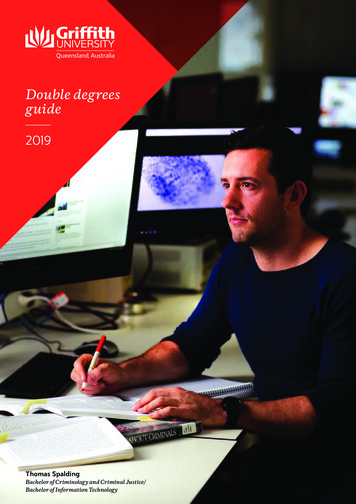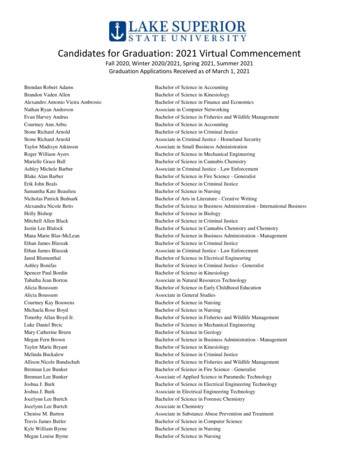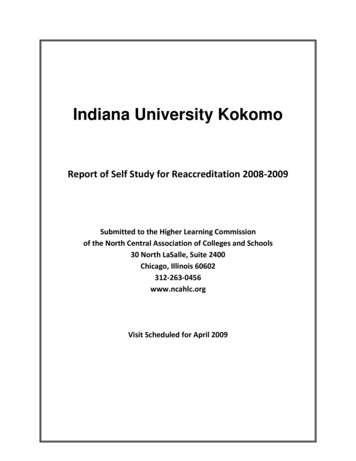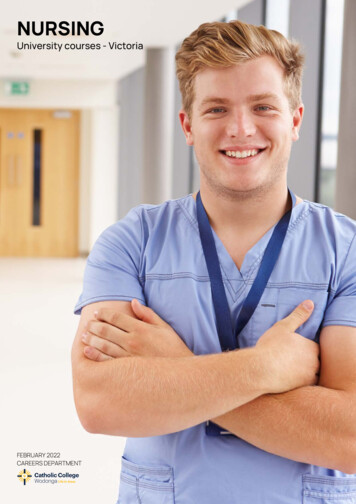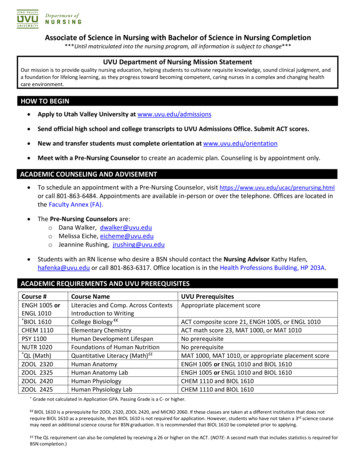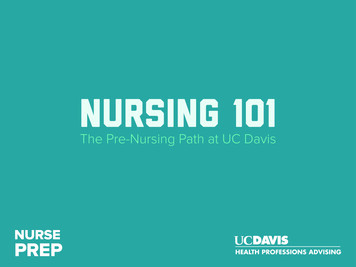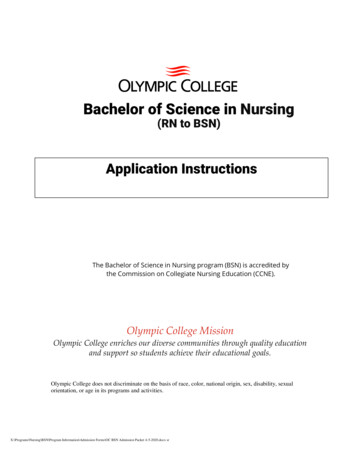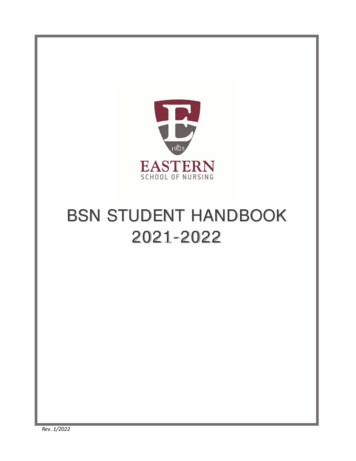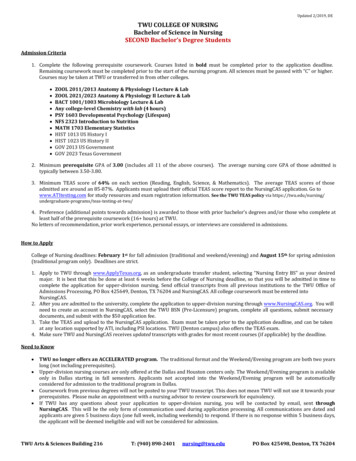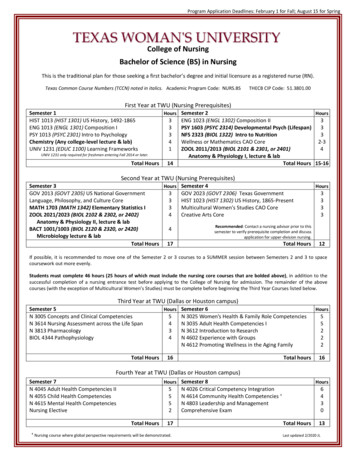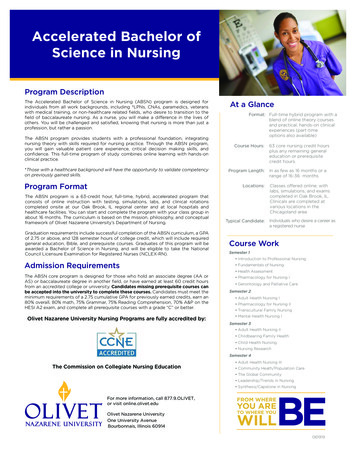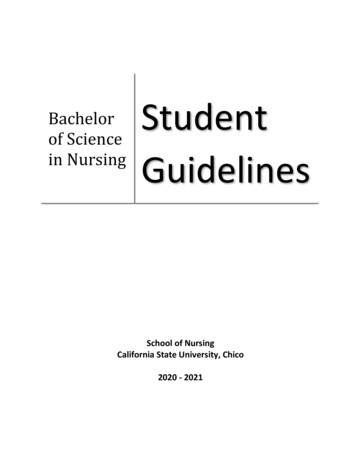
Transcription
Bachelorof Sciencein NursingStudentGuidelinesSchool of NursingCalifornia State University, Chico2020 - 2021
Table of ContentsIntroduction . 1Mission of the School of Nursing . 2University Goals and Strategic Priorities Mission of the School of Nursing:“To prepare professional nurses who are leaders, excellent clinicians and lifelong scholars.”As such, the school provides high quality, student-centered learning environments that incorporateevidence-based care and clinical reasoning. The school supports faculty and student scholarlyactivities and encourages lifelong learning. The school also fosters service to others through ourextensive community and regional collaboration with external healthcare stakeholders. 2Organizing Framework of the School of Nursing . 2Student Learning Outcomes for BSN Graduates . 4The Nursing Curriculum . 4Program Progression . 4BSN Essentials . 5Nursing Standards and Professional Behavior Expectations . 5ANA Standards of Nursing Practice . 6American Nurses Association (ANA) Code of Ethics for Nurses .14Professional Nursing Practice .14Professional Behavior and Safe Nursing Care Expectations .14Guidelines for Student Behavior .15Consequences of Student Violations . Error! Bookmark not defined.Patient Confidentiality .17Nursing Licensure .18Licensure as a Graduate versus Non-Graduate .18Interim Permit .18Public Health Nursing Certificate.19Reporting Prior Conviction or Discipline Against Licenses .19Nurse Assistant Certification .19i
Licensing Cautions for Students Providing Nursing Services for Pay .19Clinical Requirements, Health Policies and Regulations .20Emotional Requirements .20Physical Requirements .20Agency Contracts .21Dress Code .21Clinical Agency Requirements .22Health Insurance.22Automobile Access and Insurance .23Cardio-Pulmonary Resuscitation (CPR) .23Immunizations .23Professional Liability Insurance Coverage .25Background Checks, Drug Testing and Verification of Immunizations .25Student Expectations in Clinical Courses .26Clinical Absence Policy .26Potential Risks Involved with Nursing Practica, Related Policies, andProcedures .27Standard Precautions .30Bloodborne Pathogen Exposure Nursing Student Protocols .32Substance Abuse and Patient Safety: The Risks and the Consequences .34Chemical/Substance Abuse in Nursing .34Marijuana Use Following Proposition 64 .35Policy for Students Suspected of Drug or Alcohol Use/Abuse/Dependency .36Indications for Suspicion of Drug/Alcohol Impairment, Abuse, or Dependency: .37Academic Policies .40Testing Policy 39Academic Standing .40Academic Honesty .41Leaving the Program .42Writing Proficiency .42Student Participation in Governance and Decision Making.44Student Grievance Procedure .44ii
Full Time Status Requirements.45Rural Simulation Center .45Rural Simulation Center Code of Conduct .46Student Support Services .46Advising .46Tutoring and Other Learning Assistance .47Nursing Media Laboratory .47Counseling Center.48Textbooks and Course Supplements .48Student Learning Center .48Nursing Scholarships and Loans .48Graduation, Commencement, and the End of Program Pinning Ceremony .48Course Fees .49Academic Enrichment Opportunities .49Honors Program .49California Nursing Students Association .50Men in Nursing Club .50Sigma Theta Tau International/Kappa Omicron .50Appendix A - Student Nurse Background Check and Drug Testing Policy .51Students Rights .52Review Standards .52Other Provisions .53Rationale .53Appendix B - Using SentryMD/Precheck . 54Appendix C- Social Media Policy . 55Appendix D - Mobile Device Policy . .56Appendix E - Medication Administration Policy .57iii
CALIFORNIA STATE UNIVERSITY, CHICOSCHOOL OF NURSINGSTUDENT GUIDELINES: 2020-2021IntroductionThe faculty of the School of Nursing at California State University, Chico would like to welcome you tothe Nursing Program. We hope you will find the study of nursing interesting and rewarding. The course ofstudy is demanding though, and we want to be sure that you have the information you need to be successfulin achieving your goals.The guidelines in this booklet are a supplement to the "University Catalog" and have evolved over years ofstudent and faculty participation in the nursing curriculum of California State University, Chico. They weredeveloped to help you understand certain expectations of this nursing curriculum. Your suggestions tomake these guidelines continuously useful are welcomed.Successful completion of the BSN program leads to the Bachelor of Science in Nursing. This programcombines both general and professional education to prepare well-educated citizens who are alsoprofessional practitioners. Our BSN pre-licensure program is approved by the State of California Board ofRegistered Nursing. Graduates are eligible to sit for the National Council Licensure Examination forRegistered Nurses (NCLEX-RN) and to apply for the State of California Public Health Nursing Certificate.The baccalaureate degree in nursing at California State University, Chico is accredited by the Commissionon Collegiate Nursing Education (http://www.ccneaccreditation.org).The School of Nursing is an integral unit of the College of Natural Sciences at California State University,Chico, and, in accord with the primary goal of the University, provides a quality education. The School ofNursing further subscribes to the University's commitment to serve the population of northern California.The School of Nursing office is located in Trinity Hall, which is located in the center of campus. TheNursing Office is in Trinity Hall, Room 121. The Skills Lab (Holt 357) and the primary classroom (Holt363) are on the third floor of Holt Hall. The Nursing Office hours are Monday through Friday from 8:00a.m. to 5:00 p.m., during the school year. Summer hours vary. The phone number is (530) 898-5891. TheAdministrative Coordinator and the Administrative Support Assistant are available to assist students.Note: During the COVID-19 pandemic, most student services will be provided throughtelecommunication. Students needing assistance from the School of Nursing, may email the office atnursstudent@csuchico.edu or call at the number given above.The names of faculty, the location of their offices, phone numbers and office hours are posted in theBlackboard courses. Each full time faculty member holds approximately four hours of office hours perweek. Part time faculty have pro-rated office hours.1
University Mission, Vision, Strategic Priorities and Enduring Commitments:CSU Chico Mission: Chico State is the comprehensive university of the North State with a global reach.Through excellence of inquiry, innovation, and experiential learning, we develop students who arecritical thinkers, responsible citizens, diverse leaders, and inspired stewards of environmental,social, and economic resources.CSU Chico Vision: Chico State will be known as a preeminent university solving the unprecedentedchallenges of the 21st century.CSU Chico Strategic Priorities: Equity, Diversity & Inclusion Civic & Global Engagement Resilient & Sustainable SystemsCSU Chico Enduring Commitments: Academic Distinction Transformative Student Experience Prominent Scholarship and Innovation Culture of Excellence and AccountabilityThese priorities and commitments form a foundation for your nursing education at California StateUniversity, Chico.The full Chico State Strategic Plan is available at the following web shtmlMission of the School of Nursing:“To prepare professional nurses who are leaders, excellent clinicians and lifelong scholars.”As such, the school provides high quality, student-centered learning environments that incorporateevidence-based care and clinical reasoning. The school supports faculty and student scholarlyactivities and encourages lifelong learning. The school also fosters service to others through ourextensive community and regional collaboration with external healthcare stakeholders.Organizing Framework of the School of NursingA visual depiction of the mission, vision, values, strategies, program structural elements, curricularfoundations, and student learning outcomes for the undergraduate nursing program at CSU, Chico are notedon the following page. These elements provide the foundation for the development of the undergraduatecurriculum and are consistent with the mission and goals of the College of Natural Sciences and theuniversity.2
3
Student Learning Outcomes for BSN GraduatesBaccalaureate Graduates of the CSUC School of Nursing will:1. Integrate liberal education to inform baccalaureate generalist nursing practice.2. Demonstrate the knowledge and skills in leadership, quality improvement, and patient safetynecessary to provide high quality healthcare.3. Demonstrate professional practice grounded in current evidence and best practices.4. Use knowledge and skills in information management and technology to the delivery of qualitypatient care.5. Describe how financial and regulatory healthcare policies influence the nature and functioning ofthe healthcare system.6. Demonstrate communication and collaboration among healthcare professionals to achieve qualityand safe patient care.7. Utilize clinical prevention at the individual and population level to improve health.8. Demonstrate professional behavior as fundamental to the discipline of nursing.9. Provide nursing care to patients, families, groups, communities, and populations across thelifespan.10. Illustrate cultural awareness when caring for diverse patient populations.11. Demonstrate the appropriate individualized application and use of the nursing process in allbaccalaureate generalist nurse roles.The Nursing CurriculumIn this five semester program, the theory and clinical courses provide content, clinical practice, feedbackand evaluation that enable students to integrate their nursing knowledge into their science, art and humanityfoundation. The result is the progression of the student from simple to clearly more complex application ofcommunication, critical thinking, clinical reasoning, and nursing therapeutics to individuals, groups andcommunities that culminate in the meeting of the baccalaureate student learning outcomes (SLOs)described above.Program ProgressionSemester I introduces the student to the fundamental competencies essential to the beginning professionalnursing role. These include knowledge and application of interpersonal communication, critical thinking,nursing assessment, basic skills and the nursing process. Students are also introduced to evidence-basedpractice through the use of scientific data, outcomes and application in practice. (Courses N255, N283,N284, N285)4
Semester II builds on the essential competencies of Semester I and provides the biophysical foundation forthe application of decision making/clinical reasoning, communication and nursing therapeutics in the acutecare of the adult and geriatric patient. The focus of the semester is on pathophysiology, pharmacology andlaboratory data, nursing informatics and nursing research as tools for assessing, planning, implementing,documenting, and evaluating high quality nursing care. (Courses N303, N304, N311, N312)Semester III focuses on the application of theories of maternal/child nursing and family healthmaintenance as well as communication, critical thinking, clinical reasoning, and nursing therapeutics in thecare of childbearing and childrearing families in acute and community settings. Students also continue tobuild upon their knowledge base in pharmacology and medical/surgical nursing with theory courseworkand clinical application. (Courses N313, N314, N343, N344)Semester IV: Students are provided the theory and clinical opportunities to apply their decision-making,communication and nursing therapeutics to the nursing care of individuals and groups with maladaptivebehaviors in both the acute care and community settings. Students in the medical-surgical courses advancetheir knowledge of complex/high risk situations with clients across the life span in acute care settings. Thisknowledge and the associated clinical reasoning is further challenged through a capstone simulation course.An additional theoretical component in healthcare policy is provided. (Courses N400, N403, N404, N412,N413, N414)Semester V: The coursework is built upon the foundation of the preceding four semesters. Students areintroduced to the organizational management and leadership roles of professional nursing. They apply theirdecision-making, communication and nursing therapeutic skills to planning, implementing and evaluatingthe nursing care of groups of acutely ill patients. In addition, students complete theoretical and clinicalcourses in community health/public health nursing with the focus on nursing care delivery to culturallydiverse family systems. (Courses N422, N424, N474, N475).The curriculum for the CSU Chico School of Nursing provides the following content identified by theAmerican Association of Colleges of Nursing as essential to BSN education.BSN EssentialsEssential I: Liberal education for baccalaureate generalist nursing practice.Essential II: Basic organizational and systems leadership for quality care and patient safety.Essential III: Scholarship for evidence-based practice.Essential IV: Information management and application of patient care technology.Essential V: Healthcare policy, finance, and regulatory environments.Essential VI: Interprofessional communication and collaboration for improving patient health outcomes.Essential VII: Clinical prevention and population health.Essential VIII: Professionalism and professional values.Essential IX: Baccalaureate generalist nursing practice.Nursing Standards and Professional Behavior ExpectationsThe American Nurses Association has defined standards and codes by which all nurses are expected topractice. As a professional program it is expected that CSU Chico nursing students will demonstratebehaviors that reflect the defined standards of nursing throughout their academic experience.5
ANA Standards of Nursing PracticeStandard 1. AssessmentThe registered nurse collects pertinent data and information relative to the healthcare consumer’s health orthe situation.CompetenciesThe registered nurse: Collects pertinent data, including but not limited to demographics, social determinants of health,health disparities, and physical, functional, psychosocial, emotional, cognitive, sexual, cultural,age-related, environmental, spiritual/transpersonal, and economic assessments in a systematic,ongoing process with compassion and respect for the inherent dignity, worth, and unique attributesof every person. Recognizes the importance of the assessment parameters identified by WHO (World HealthOrganization), Healthy People 2030, or other organizations that influence nursing practice. Integrates knowledge from global and environmental factors into the assessment process. Elicits the healthcare consumer’s values, preferences, expressed and unexpressed needs, andknowledge of the healthcare situation. Recognizes the impact of one’s own personal attitudes, values, and beliefs on the assessmentprocess. Identifies barriers to effective communication based on psychosocial, literacy, financial, andcultural considerations. Assesses the impact of family dynamics on healthcare consumer health and wellness. Engages the healthcare consumer and other interprofessional team members in holistic, culturallysensitive data collection. Prioritizes data collection based on the healthcare consumer’s immediate condition or theanticipated needs of the healthcare consumer or situation. Uses evidence-based assessment techniques, instruments, tools, available data, information, andknowledge relevant to the situation to identify patterns and variances. Applies ethical, legal, and privacy guidelines and policies to the collection, maintenance, use, anddissemination of data and information. Recognizes the healthcare consumer as the authority on their own health by honoring their carepreferences. Documents relevant data accurately and in a manner accessible to the interprofessional team.Standard 2. DiagnosisThe registered nurse analyzes assessment data to determine actual or potential diagnoses, problems, andissues.CompetenciesThe registered nurse: Identifies actual or potential risks to the healthcare consumer’s health and safety or barriers tohealth, which may include but are not limited to interpersonal, systematic, cultural, orenvironmental circumstances. Uses assessment data, standardized classification systems, technology, and clinical decisionsupport tools to articulate actual or potential diagnoses, problems, and issues. Verifies the diagnoses, problems, and issues with the individual, family, group, community,population, and interprofessional colleagues. Prioritizes diagnoses, problems, and issues based on mutually established goals to meet the needsof the healthcare consumer across the health–illness continuum. Documents diagnoses, problems, and issues in a manner that facilitates the determination of theexpected outcomes and plan.6
Standard 3. Outcomes IdentificationThe registered nurse identifies expected outcomes for a plan individualized to the healthcare consumer orthe situation.CompetenciesThe registered nurse: Engages the healthcare consumer, interprofessional team, and others in partnership to identifyexpected outcomes. Formulates culturally sensitive expected outcomes derived from assessments and diagnoses. Uses clinical expertise and current evidence-based practice to identify health risks, benefits, costs,and/or expected trajectory of the condition. Collaborates with the healthcare consumer to define expected outcomes integrating the healthcareconsumer’s culture, values, and ethical considerations. Generates a time frame for the attainment of expected outcomes. Develops expected outcomes that facilitate coordination of care. Modifies expected outcomes based on the evaluation of the status of the healthcare consumer andsituation. Documents expected outcomes as measurable goals. Evaluates the actual outcomes in relation to expected outcomes, safety, and quality standards.Standard 4. PlanningThe registered nurse develops a plan that prescribes strategies to attain expected, measurable outcomes.CompetenciesThe registered nurse: Develops an individualized, holistic, evidence-based plan in partnership with the healthcareconsumer and interprofessional team. Establishes the plan priorities with the healthcare consumer and interprofessional team. Advocates for responsible and appropriate use of interventions to minimize unwarranted orunwanted treatment and/or healthcare consumer suffering. Prioritizes elements of the plan based on the assessment of the healthcare consumer’s level of riskand safety needs. Includes evidence-based strategies in the plan to address each of the identified diagnoses,problems, or issues. These strategies may include but are not limited to:o Promotion and restoration of health,o Prevention of illness, injury, and disease,o Facilitation of healing,o Alleviation of suffering, ando Supportive care Incorporates an implementation pathway that describes steps and milestones. Identifies cost and economic implications of the plan. Develops a plan that reflects compliance with current statutes, rules and regulations, and standards. Modifies the plan according to the ongoing assessment of the healthcare consumer’s response andother outcome indicators. Documents the plan using standardized language or recognized terminology.Standard 5. ImplementationThe registered nurse implements the identified plan.CompetenciesThe registered nurse:7
Partners with the healthcare consumer to implement the plan in a safe, effective, efficient, timely,patient-centered, and equitable manner (IOM, 2010).Integrates interprofessional team partners in implementation of the plan through collaboration andcommunication across the continuum of care.Demonstrates caring behaviors to develop therapeutic relationships.Provides culturally congruent, holistic care that focuses on the healthcare consumer and addressesand advocates for the needs of diverse populations across the lifespan.Uses evidence-based interventions and strategies to achieve the mutually identified goals andoutcomes specific to the problem or needs.Integrates critical thinking and technology solutions to implement the nursing process to collect,measure, record, retrieve, trend, and analyze data and information to enhance nursing practice andhealthcare consumer outcomes.Delegates according to the health, safety, and welfare of the healthcare consumer and consideringthe circumstance, person, task, direction or communication, supervision, evaluation, as well as thestate nurse practice act regulations, institution, and regulatory entities while maintainingaccountability for the care.Documents implementation and any modifications, including changes or omissions, of theidentified plan.Standard 5A. Coordination of CareThe registered nurse coordinates care delivery.CompetenciesThe registered nurse: Organizes the components of the plan. Collaborates with the consumer to help manage health care based on mutually agreed uponoutcomes. Manages a healthcare consumer’s care in order to reach mutually agreed upon outcomes. Engages healthcare consumers in self-care to achieve preferred goals for quality of life. Assists the healthcare consumer to identify options for care. Communicates with the healthcare consumer, interprofessional team, and community-basedresources to effect safe transitions in continuity of care. Advocates for the delivery of dignified and holistic care by the interprofessional team. Documents the coordination of care.Standard 5B. Health Teaching and Health PromotionThe registered nurse employs strategies to promote health and a safe environment.CompetenciesThe registered nurse: Provides opportunities for the healthcare consumer to identify needed healthcare promotion diseaseprevention, and self-management topics. Uses health promotion and health teaching methods in collaboration with the healthcareconsumer’s values, beliefs, health practices, developmental level, learning needs, readiness andability to learn, language preference, spirituality, culture, and socioeconomic status. Uses feedback and evaluations from the healthcare consumer to determine the effectiveness of theemployed strategies. Uses technologies to communicate health promotion and disease prevention information to thehealthcare consumer. Provides healthcare consumers with information about intended effects and potential adverseeffects of the plan of care.8
Engages consumer alliance and
The School of Nursing is an integral unit of the College of Natural Sciences at California State University, Chico, and, in accord with the primary goal of the University, provides a quality education. . challenges of the 21st century. CSU Chico Strategic Priorities: Equity, Diversity & Inclusion Civic & Global Engagement
